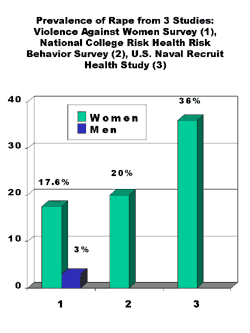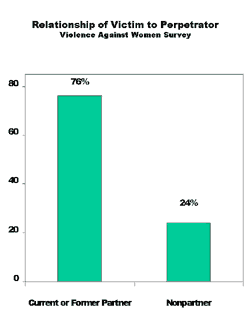Mary P. Koss, Ph.D.
In the early 1990s, the media ran stories accusing feminists of using rape statistics to create a "phantom epidemic." However, recent studies provide powerful new evidence that the U.S. indeed has a rape problem.
Below are results from several surveys whose
numbers tell a story about the prevalence of rape in our society.
Violence Against Women Survey - The US Department of Justice funded a
national survey of 8,000 Americans. Findings included:
![]() 17.6%
of women reported having been raped.
17.6%
of women reported having been raped.
![]() 3% of men reported
having been raped.
3% of men reported
having been raped.
![]() Slightly more
than half of first-time rape victims were less than 18 years old.
Slightly more
than half of first-time rape victims were less than 18 years old.
![]() 76% of women
raped and/or physically assaulted after age 18 were attacked by a current
or former husband, cohabitating partner or a date.
76% of women
raped and/or physically assaulted after age 18 were attacked by a current
or former husband, cohabitating partner or a date.
(Tjaden & Thoennes, 1998)
The Nal College Risk Health Risk Behavior Survey
This survey of 4,838 college students was funded by the Centers for Disease
Control and Prevention. Findings included:
This figure is virtually identical to data collected by Koss, Gidycz, & Wisniewski (1987;
 Note:
That figure, combined with the statistics for attempted rape, formed the
basis for the widely used 1-in-4-risk estimate for college women. Now limited
to completed rape, the estimate is 1 in 5 .
Note:
That figure, combined with the statistics for attempted rape, formed the
basis for the widely used 1-in-4-risk estimate for college women. Now limited
to completed rape, the estimate is 1 in 5 . The US Naval Recruit Health Study
This national sample of 3,776 male and female recruits was surveyed during basic training. Findings included:
This national sample of 3,472 college students was administered the National Crime Victimization Survey questions. The survey included highly criticized questions about rape that refer to a sexual attack without elaboration. Findings included:
 Such important qualifiers
are often lost in the journalistic process. With the single exception of
poor data on rape prevalence among ethnic groups (see Ramos, Koss, &
Russo, 1999), assertions that we don't have good data or that we need to
devote more resources toward the ultimate survey should be rejected.
Such important qualifiers
are often lost in the journalistic process. With the single exception of
poor data on rape prevalence among ethnic groups (see Ramos, Koss, &
Russo, 1999), assertions that we don't have good data or that we need to
devote more resources toward the ultimate survey should be rejected. The US has a rape problem. Prevalence rates above 15% have been thoroughly demonstrated.
As advocates, we must fight to devote research funds to understanding why men rape. We must design and implement prevention programs to learn more about teaching women how to respond in rape or potential rape situations. We must also foster a sensitive community response to rape survivors.
Bibliography
Brenner, N.D., McMahon, P.M., Warren, C.W., & Douglas, K.A. (1999). Forced sexual intercourse and associated health-risk behaviors among female college students in the United States. Journal of Consulting and Clinical Psychology, 67, 252-259.
Fisher, B.S., Sloan, J.J., Cullen, F.T., & Lu, C. (1998). Crime in the ivory tower: The level and sources of student victimization. Criminology, 36, 671-699.
Koss, M.P., Gidycz, C.A., & Wisniewski, N. (1987). Incidence and prevalence of sexual aggression and victimization in a national sample of higher education students. Journal of Consulting and Clinical Psychology, 55, 162-170.
Merrill, L.L., Newell, C.E., Milner, J.S., Koss, M.P., Hervig, L.K., Gold, S.R., Rosswork, S.G., Thornton, S.R. (1998). Prevalence of premilitary adult sexual victimization and aggression in a Navy recruit sample. Military Medicine, 163, 209-212.
Ramos, L.L., Koss, M.P., & Russo, N.F. (1999). Mexican American women. s definitions of rape and sexual abuse. Hispanic Journal of Behavioral Sciences, 21, 236-265.
Tjaden, P., & Thoennes, N. (1998, November). Prevalence, incidence, and consequences of violence against women: Findings from the National Violence Against Women Survey. National Institute of Justice Centers for Disease Control and Prevention Research in Brief, 1-16
| Feedback | Join Us | Site Map | VAWPrevention Home |
| National Violence Against Women Prevention Research Center © Copyright 2000 | |||
| (843) 792-2945/telephone (843) 792-3388/fax | |||